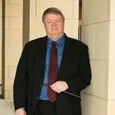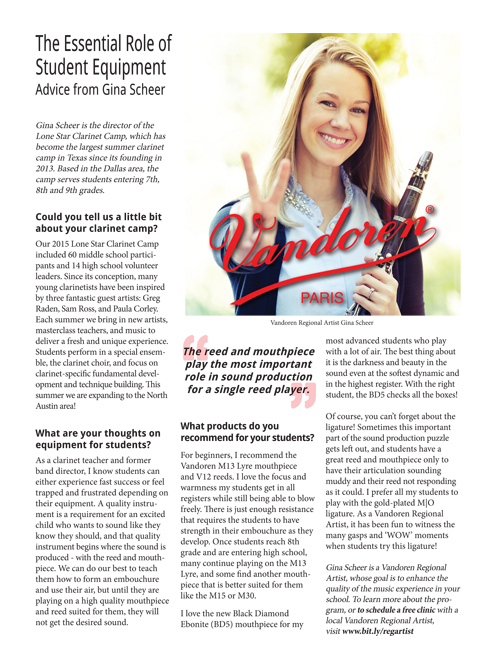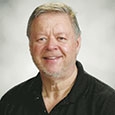Part one of this article may be found here.
With three weeks of band class under their belts, students turn toward a much heavier focus on playing their instruments, all while continuing to review the fundamentals they learned in the first three weeks.
Week Four
This is a continuation of the same fundamentals and procedures from week three; we practice the same material until it is habitual. We teach fundamentals as steps that must be mastered before we can go on, like progressing in karate. If a student has not mastered breathing he will never make a steady sound, and he will never master breathing if he hasn’t mastered posture.
Articulating
So far we have avoided talking about the tongue, having students start sounds using air. Usually by week four students can hold single notes steady, and then we work on articulations. We have students say “Teeny tiny tater tots tiptoed to town” and feel where their tongue touches. The mental image we give is to say the phrase using only one taste bud. Stressing that the air should be continuous, I have students play a note for eight to ten counts, and every time I snap my fingers, they raise the front part of their tongue to where the gums touch the back of the top teeth and then immediately return it flat to the bottom of there mouth. The tongue moves up and down, not forward and back. Single reed instruments are taught “The top of the tip of the tongue touches the top of the tip of the reed.”
During this exercise I make sure that students do not stop or slow the air as the tongue approaches. This is one of the biggest errors beginners make. To counteract this, I teach them a few phrases:
- Lungs are dumb. Lungs think every note is single ten-count note
- Tongue is smart. The tongue knows to cut up the long pieces of air into rhythms.
- Lips are lazy. When asked to change notes, lips will always take the easiest route unless they are made to work correctly by airspeed and embouchure. An example I give for trumpet is “The lips think, ‘Why go up to the second space A when I have a perfectly good E I can play with the same fingering?’”
- Foot is boring. No matter what the tongue and fingers do, the foot just goes up and down like a machine. I am a huge believer in using foot tapping and a strong metronome during the first few years of playing. Both are constant in my beginning rehearsals. After middle school students can transition to toe tapping and non-tapping.
I find that most of the tonguing errors young students make are consistent. When they tongue students must freeze the face, tongue at the same spot in your mouth (or on the reed) with the same firmness every time, and use one taste bud. In addition there should be continuous air through the articulation. These ideas will solve many tonguing problems.
I use the picture of an oscillating sprinkler head. The water comes out strong and uninterrupted, and the little metal bar that bounces off the water stream is exactly what the tongue should be doing inside the mouth.
Week four is also when we focus on learning concert F and going down through, Eb, D, C, and Bb, especially with brass players. We pay close attention to how their sound is when moving from note to note and make sure that they are adhering to all the fundamentals we have worked on. For brass we stress opening up the teeth when going down, telling them “The lips decide what note you hit, but the teeth decide how the note will sound.” After we can change the notes on the beat with a good, steady sound then we are ready to explore the band method book.
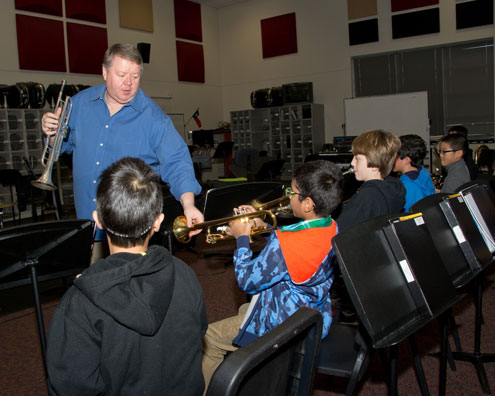
The sequence I always use – count, say, buzz, play – when learning a book line takes some time but is effective. Students first count the line while tapping the foot to the metronome. I count along with the students, but I count at a mezzo-piano volume, and the students have to count louder than me or we stop and do it again. After this, we say note names with the metronome while fingering and tapping. For the first week or so we just say the note names in time, and from then on we sing the note names on pitch. At this point brass players buzz the line on BERPs, then we play the line.
Once students start, they are committed to finishing the line no matter what goes wrong. Students must learn to not pause or give up when they play. By using this process you avoid students only learning to play a little of a line and then crashing and burning.
Week Five
We spend a great deal of time making sure all the students can play the first few lines before moving on to more songs. This is a very difficult time for the students who are struggling a bit. Think about what we are asking these 11 year olds to do at the same time to play a song: sit a certain way, hold instruments a certain way, move fingers a certain way, breathe in and out a certain way, set the face a certain way, tongue a certain way, tap a foot, and read music – and we have not even started to add slurs or dynamics.
Students have an online homework assignment to learn note reading faster. This week students are to visit www.8notes.com and complete 100 correct notes names with no more than two mistakes or they have to restart. We give extra credit for correct answers over 100, but students still cannot get more than two percent of their answers wrong. Some students make a game of it and do hundreds. We only do this assignment once, but later in the fall we add a time test website, www.musicracer.com, for note recognition. In December, once the students know more fingerings, we go back for one last assignment at www.musicracer.com, where they have to pick fingerings for their instruments as a time test. This website even has a hall of fame for the quickest times. Students get quite competitive with this.
Weeks four and five are also when student ability levels become apparent. We ask struggling students to come in before or after school to get help, especially if they are not in private lessons.
As we start putting everything together I teach students the four Ts: Tongue, Toe, and Tinger, with the Ticker. “Tinger” means finger; I changed the first letter so I could have four Ts. It is so silly that students remember it easily.
It is essential to play close attention to fundamentals when students play book lines. Usually fundamentals are forgotten because students are concentrating so hard on the note name and correct fingering. The instrument level drops, feet start curling around the leg of the chair, and sound stops between notes. We simply correct the problem and have students play the whole line again, as many times as it takes.
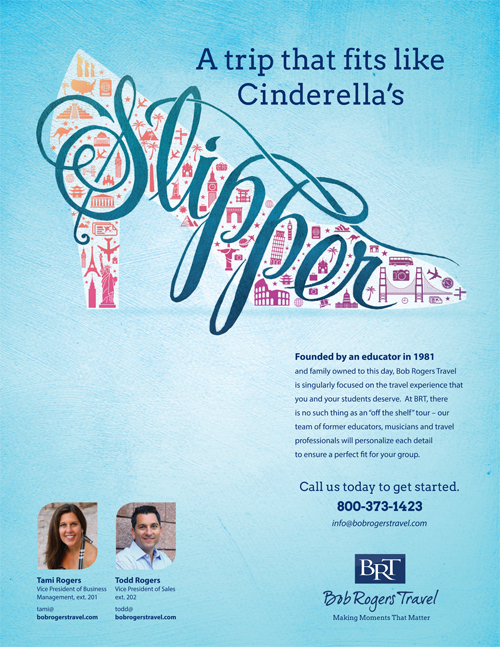
Week Six
By the sixth week we do the Alphabet Master only once or twice a week and breathing exercises a few times a week. Students continue learning book lines, but these are supplemented with exercises and music we write, including more rhythm work. We play half a page of rhythm charts several times a week. Brass players start basic lip slurs, and woodwinds learn many more notes.
We build a repertoire of melodies to use when students learn enough notes. The binder of everything I need for teaching each of my instrument classes includes a wealth of simple tunes. My friend and co-worker Jonathan Adamo arranged a collection of beautiful tunes, such as Auld Lang Syne and Loch Lomond. We use these to talk about phrasing and intonation.
Any time I find something fun I put it in my binder. I even have bugle calls to teach trumpet players in the spring. If any of my colleagues find melodic tunes, we share these with each other. I had a beginning tuba player find a melody from Lord of the Rings online. Some students even try to arrange (with our help) pop songs they hear on the radio. The aim is to use anything that will get the kids playing more often and make them hungry for more music.
General Comments
We only have one beginner concert in the fall. In November there is a demonstration concert for each section of the beginning band. My friend John Timpani at Clark Middle School in Frisco used Garage Band to write amazing accompaniment tracks for a few of the method book songs, and each section plays a few one-line songs out of the method book with the accompaniment track in loud speakers. Students also play a song that we arrange for them. This might be Star Wars for trumpets or The Empire Strikes Back for tubas. After our finale, Hard Rock Blues, the top band performs two songs at the end of the beginner concert to get the kids excited about what they will be able to do a year from now.
In November we teach the Remington warmup to all sections. This extends the range and teaches chromatic notes and the alternate woodwind fingerings. We also begin work on the F chromatic scale this month. There is a heavy emphasis on scales and arpeggios in the spring, and we have an elaborate pass-off system for learning all the major scales and a full-range chromatic by the end of the school year.
Beginners do not have a holiday concert, as we are just starting to learn and pass off a few scales in December. However, after Thanksgiving we learn 14-15 unison holiday tunes and walk around the neighborhood one night and perform with the seventh and eighth graders. It is a great way for beginners to feel like they are real musicians, and our older kids are very kind and supportive of them. We use these holiday tunes in their beginning band year to teach skills like first and second endings, accidentals, dotted rhythms, and syncopated rhythms.
Spring is when all the time spent on fundamentals pays off, as students can learn new songs quickly. We give the students a song like Jurassic Park at the end of class on a Friday and and mention that they could practice it this weekend if they wanted to. The next Friday I might drop Pirates of the Caribbean on them before they leave. Each Friday there is anticipation from students about what I will give them for the weekend.
We have excellent seventh and eighth grade bands with dozens of students making All-Region Band, and it is entirely because of the work done when they start in sixth grade. This is not just what we do technically, but the culture we develop. Any fundamental problem present in your older students means something should be changed or added to the beginning band curriculum. I love teaching beginning band this way because when beginners advance to seventh and eighth grade, rehearsing the advanced band is like getting to drive a Ferrari every day.
If I can answer any questions about what we do or be of any help with your program, do not hesitate to contact me at DunhamD@friscoisd.org.
